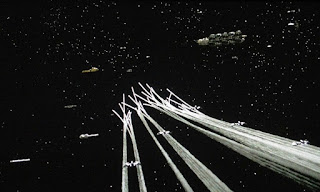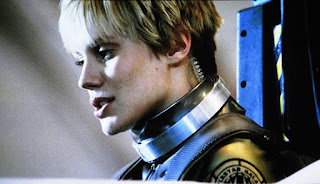What if God decided he made a mistake?
And he decided to give souls to another creature like the Cylons."
-Leoben-
"God didn't create the Cylons, man did.
And I'm pretty sure we didn't include a soul in the programming."
- Commander Husker Adama-
"Doesn't matter. Sooner or later, the day comes when you can't hide from the things you've done."
-Leoben-



Battlestar Galactica is a series with a lot on its mind about the state of humanity and human behavior.
In our (Part I) look at Ronald D. Moore's Battlestar Galactica (2003-2009) here we discussed a handful of the flawed characters of which Moore created for the series. In particular we looked at some of the alleged good guys and, of course, with the reimagined Battlestar Galactica we use that term and descriptor, good, rather loosely.

For Battlestar Galactica, The Mini-Series (Part II) it's also worth noting the alleged bad guys aren't rotten to the core in the traditional sense of the villainous archetype. Instead Moore presents the imperfection and duality of the ever flawed human being alternating between both. In other words all of us are replete with some major character flaws never completely good or bad.
Gaius Baltar, played with precision by James Callis, in particular is perhaps one of the weakest links in the human race, a man susceptible to the lures of female flesh and desire. His relationship with Cylon Number Six would in effect, unwittingly, bring about the downfall of Caprica and, overall, the Twelve Colonies. A small mistake, but actions have consequences like the very existence of the Cylons by human hands. Some things get out of their box like the dramatization of a big thing with small beginnings like the protomolecule in The Expanse (2015-present). It's hard to put it back in the box.

But rather than be an out and out villain pursuing the rag tag fleet across the galaxy like the Baltar from the classic Glen A. Larson series Battlestar Galactica (1978-1979), as portrayed by the late John Colicos, this Baltar is far more spineless, sometimes conniving, opportunistic and yet sympathetic. In other words this Baltar is multi-dimensional, and a bit like some percentage of humanity. Baltar doesn't exhibit the best of our traits. A self-serving, self-professed and perceived genius Baltar is perhaps amoral, but not without conscience. He is aware that the things he chooses have consequences. Sometimes the results are good, but often they can be devastating. And unlike the Baltar of old, this Baltar is infused within the ragtag fleet and living precariously amidst the very humanity he has inadvertently destroyed. He is like Dr. Zachary Smith (Lost In Space), a man you love and hate. Like Harris and even more complicated, Baltar is complex and fallible at once pathetic and sympathetic. Baltar is the series wild card at the beckon call of a seductress, a Cylon devil (in a red dress) in Number Six.

Lethal antagonist Number Six, played seductively by Tricia Helfer, also leaves an indelible imprint upon the series.
The Cylons were after all born of humanity. These were, in effect, our children. Helfer described the character fittingly, "Number Six is a bit like a child. She has emotions but she doesn't quite understand them or know how to deal with them. And sometimes when she doesn't get what she wants, she lashes out a bit like a child might. She's experiencing and learning and growing ..., but she's also still a Cylon, or she's seeing things in different ways than a human might." And our children are coming home.

The Mini-Series (Part II) see the Battlestar Galactica FTL hyper-jump to Ragnar Station Ammunition Reserve in the hopes of acquiring weapons.
The second installment further illustrates the Battlestar as an anachronistic battle ship woven with old school analog type technologies. Corded receivers, sliding levers and turn keys work in combination with digital screens, but the ship is far from state of the art. This works to the advantage of the human race in surviving the technologically advanced Cylons from infiltration of the ship's systems.

Boomer makes a point regarding the contrasting technologies. The Cylons clearly have superior technology capable of disabling the more advanced technology of the Colonial fleet, but Boomer alludes to the fact that the older Viper models are more effective against their enemy. The entry alludes to the advantage of the Galactica's older technology going forward in the series in its war against the Cylons. "Our computers aren't networked."
The big revelation for the new series is that the Cylons, beyond the metallic Centurion model, now look like us. It begs the question, how can we trust each other?

It's true the original 1970s series never quite established the truth regarding the creation of the Cylons by a lizard-like race. Here, Moore's recreation of the Cylons are very clearly man-made.
Now Cylons look like their creators allowing for a much murkier and more darkly complex commentary on the state of human nature. This was a stroke of genius in tapping into the psychology of post-9/11 American thinking.
"This just gets worse and worse" complains XO Tighe Saul. "Now the Cylons look like us. You realize what this means. It could be anywhere, anyone." Adama retorts on the difficulty at hand, noting the Cylons are indistinguishable "down to our blood." This is precisely the conundrum faced by Americans and those tasked with our security while balancing human rights to this very day. The enemy doesn't play by the rules making it that much harder to differentiate good from evil.

One of the more fascinating dialogue exchanges (though there are many) occurs between Adama and Laura Roslin, surely a sign of things to come. Both jockey for their respective leadership positions regarding what to do next. Adama hawkishly declares we are at war. Roslin, the dove, seeks to cut and run following the human losses so that the human race might prosper once again.
The schism between the two could not more clearly define the road America has taken since 9/11 and the election of Barack Obama. It has never been more divided. But seeing the series through to its conclusion one can find hope amidst the fractured human race.

Meanwhile Starbuck has spotted two Cylon Basestars and an enemy fleet that awaits the Galactica's departure of Ragnar station and the electro magnetic storm field that protects the Colonial fleet from the Cylons.
The Mini-Series (Part II) serves up one of those quintessential Battlestar Galactica epic battles (thankfully with none of those beloved vintage era Viper effects on repeat). The action sequences are breathtakingly good fun and a sign of things to come for the series. Seeing the effects work completed on the series today and it still remains impressive. Quite honestly the science fiction fan in me had been waiting for the kind of space battles depicted in this series for a long time and they are flawless in Battlestar Galactica.
There is a moment in the space battle where Starbuck must rescue Apollo. The sequence sees her viper connect with Apollo's Viper to rescue him. There is a visual symbolism there that magnifies the connection between these two characters that fits. It still echoes the old series in this way. It also recognizes the two characters are indelibly linked and would be throughout Moore's series.

In the final act, Adama lies about the location of Earth to the colony to inspire hope. The scene at once amplifies the flawed nature of humanity to be founded on a series of deceptions and lies, but also begs the question when is it a noble act to withhold information to inspire a people? The lie is not evil in and of itself. Theses decisions never offer easy answers. They ask us if we always need to know the truth of things. Do we need to know every action our government takes? Certainly our leaders tell us their version of the truth anyway so what ultimately is the truth?

It is revealed to Adama that there are twelve (12) human Cylon models. Four are established in The Mini-Series (Leoben Conoy, Aaron Doral, Six) with the cliffhanger landing on Sharon "Boomer" Valerii as a fifth (with seven remaining). Folks at home are reminded, alongside the cigar smoking female Starbuck and an alcoholic XO in Saul Tigh, this will clearly not be morally courageous or just effort of the noble Battlestar Galactica of the 1970s.
Dialogue homages to the classic series are in place. Lines like "by your command" and "life here began out there" populate the series. Characters too were revisited in different forms to pay respect but also reinvent from Starbuck to the shocking revelation that once beloved pilot Boomer would now be a Cylon. Sorry Herbert Jefferson Jr..

The Mini-Series for the reimagined Battlestar Galactica proved it had plenty on its mind and plenty to say about the world following the terrorist acts of September 11, 2001. The series would become a referendum on American domestic and foreign policy. It would ask serious questions about the potential for cultural harmony between Christians and Muslims through questions of trust, deceit and often despicable human behavior, as portrayed by humans and Cylon representatives, on both sides. While I prefer a more hawkish view on these matters the series would offer evidence that pure annihilation of a radical Muslim threat and ideology was but pure fantasy. It reflected upon our leaders as sometimes flawed and self-serving. Interpretations on human behavior and our political leaders were indeed mostly negative and sadly uninspired.

As a feature, The Mini-Series is outstanding in every facet of its production---casting, performance, story, writing and originality. Most of all this is a science fiction series that offers a window into one of the most dramatic looks at the dark side of humanity under the duress of very difficult times. Battlestar Galactica as a science fiction is also a riveting human drama.
Writer: Ronald D. Moore/ Glen A. Larson. Director: Michael Rymer.




























































No comments:
Post a Comment